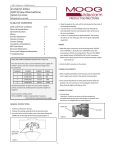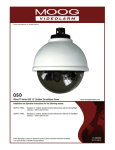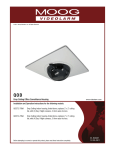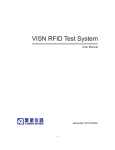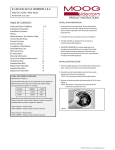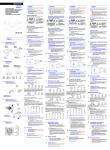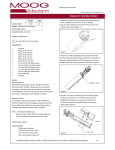Download Moog Videolarm QSDWT2-70NA5 surveillance camera
Transcript
© 2009, Videolarm, Inc. All Rights Reserved QSDW and QSDP QView Series QSD Outdoor Dome www.videolarm.com Installation and Operation Instructions for the following models: CERTIFIED © 2009, Videolarm, Inc. All Rights Reserved Before attempting to connect or operate this product, please read these instructions completely. 81-IN5362 02-03-2009 IMPORTANT SAFEGUARDS 1. Read Instructions - All the safety and operating instructions should be read before the unit is operated. 2. Retain Instructions - The safety and operating instructions should be retained for future reference. 3. Heed Warnings - All warnings on the unit and in the operating instructions should be adhered to. 4. Follow Instructions - All operating & user instructions should be followed. 5. Electrical Connections - Only a qualified electrician should make electrical connections. 6. Attachments - Do not use attachments not recommended by the product manufacturer as they may cause hazards. 7. Cable Runs - All cable runs must be within permissible distance. 8. Mounting - This unit must be properly and securely mounted to a supporting structure capable of sustaining the weight of the unit. Accordingly: a. Installation should be made by a qualified installer. b. Installation should be in compliance with local codes. c. Care should be exercised to select suitable hardware to install the unit, taking into account both the composition of the mounting surface and the weight of the unit. Be sure to periodically examine the unit and the supporting structure to make sure that the integrity of the installation is intact. Failure to comply with the foregoing could result in the unit separating from the support structure and falling, with resultant damages or injury to anyone or anything struck by the falling unit. UNPACKING Unpack carefully. Electronic components can be damaged if improperly handled or dropped. If an item appears to have been damaged in shipment, replace it properly in its carton and notify the shipper. Be sure to save: 1. The shipping carton and packaging material. They are the safest material in which to make future shipments of the equipment. 2. These Installation and Operating Instructions. SAFETY PRECAUTIONS ! CAUTION RISK OF ELECTRIC SHOCK! CAUTION: TO REDUCE THE RISK OF ELECTRICAL SHOCK, DO NOT EXPOSE COMPONENTS TO WATER OR MOISTURE. The lightning flash with an arrowhead symbol, within an equilateral triangle, is intended to alert the user to the presence of non-insulated "dangerous voltage" within the product's enclosure that may be of sufficient magnitude to constitute a risk of electric shock to persons. ! The exclamation point within an equilateral triangle is intended to alert the user to presence of important operating and maintenance (servicing) instructions in the literature accompanying the appliance. SERVICE If the unit ever needs repair service, customer should contact Videolarm (1-800-554-1124) for return authorization & shipping instructions. TECHNICAL SUPPORT Videolarm has set-up a 24 hour technical support line for their customers. 24 HOUR TECHNICAL SUPPORT 1-800-554-1124 LIMITED WARRANTY FOR VIDEOLARM INC. PRODUCTS VIDEOLARM INC. warrants this Product to be free from defects in material or workmanship, as follows: PRODUCT CATEGORY PARTS LABOR All Enclosures and Electronics Five (5) Years Five (5) Years Pan/Tilts Three (3) Years **6 months if used in autoscan Three (3) Years **6 months if used in autoscan / tour operation Poles/PoleEvators Three (3) Years / tour operation Three (3) Years Warrior/Q-View/I.R. Illuminators Five (5) Years Five (5) Years SView Series Five (5) Years **6 months if used in autoscan Five (5) Years **6 months if used in autoscan Controllers Five (5) Years / tour operation Five (5) Years / tour operation Power Supplies Five (5) Years Five (5) Years Five (5) Years Five (5) Years Accessory Brackets During the labor warranty period, to repair the Product, Purchaser will either return the defective product, freight prepaid, or deliver it to Videolarm Inc. Decatur GA. The Product to be repaired is to be returned in either its original carton or a similar package affording an equal degree of protection with a RMA # (Return Materials Authorization number) displayed on the outer box or packing slip. To obtain a RMA# you must contact our Technical Support Team at 800.554.1124, extension 101. Videolarm will return the repaired Product freight prepaid to Purchaser. Videolarm is not obligated to provide Purchaser with a substitute unit during the warranty period or at any time. After the applicable warranty period, Purchaser must pay all labor and/or parts charges. The limited warranty stated in these product instructions is subject to all of the following terms and conditions: 1. NOTIFICATION OF CLAIMS: WARRANTY SERVICE: If Purchaser believes that the Product is defective in material or workmanship, then written notice with an explanation of the claim shall be given promptly by Purchaser to Videolarm but all claims for warranty service must be made within the warranty period. If after investigation Videolarm determines that the reported problem was not covered by the warranty, Purchaser shall pay Videolarm for the cost of investigating the problem at its then prevailing per incident billable rate. No repair or replacement of any Product or part thereof shall extend the warranty period as to the entire Product. The specific warranty on the repaired part only shall be in effect for a period of ninety (90) days following the repair or replacement of that part or the remaining period of the Product parts warranty, whichever is greater. 2. EXCLUSIVE REMEDY: ACCEPTANCE: Purchaser’s exclusive remedy and Videolarm’s sole obligation is to supply (or pay for) all labor necessary to repair any Product found to be defective within the warranty period and to supply, at no extra charge, new or rebuilt replacements for defective parts. 3. EXCEPTIONS TO LIMITED WARRANTY: Videolarm shall have no liability or obligation to Purchaser with respect to any Product requiring service during the warranty period which is subjected to any of the following: abuse, improper use: negligence, accident, lightning damage or other acts of God (i.e., hurricanes, earthquakes), modification, failure of the end-user to follow the directions outlined in the product instructions, failure of the end-user to follow the maintenance procedures recommended by the International Security Industry Organization, written in product instructions, or recommended in the service manual for the Product. Furthermore, Videolarm shall have no liability where a schedule is specified for regular replacement or maintenance or cleaning of certain parts (based on usage) and the end-user has failed to follow such schedule; attempted repair by non-qualified personnel; operation of the Product outside of the published environmental and electrical parameters, or if such Product’s original identification (trademark, serial number) markings have been defaced, altered, or removed. Videolarm excludes from warranty coverage Products sold AS IS and/or WITH ALL FAULTS and excludes used Products which have not been sold by Videolarm to the Purchaser. All software and accompanying documentation furnished with, or as part of the Product is furnished “AS IS” (i.e., without any warranty of any kind), except where expressly provided otherwise in any documentation or license agreement furnished with the Product. 4. PROOF OF PURCHASE: The Purchaser’s dated bill of sale must be retained as evidence of the date of purchase and to establish warranty eligibility. DISCLAIMER OF WARRANTY EXCEPT FOR THE FOREGOING WARRANTIES, VIDEOLARM HEREBY DISCLAIMS AND EXCLUDES ALL OTHER WARRANTIES, EXPRESS OR IMPLIED, INCLUDING, BUT NOT LIMITED TO ANY AND/OR ALL IMPLIED WARRANTIES OF MERCHANTABILITY, FITNESS FOR A PARTICULAR PURPOSE AND/OR ANY WARRANTY WITH REGARD TO ANY CLAIM OF INFRINGEMENT THAT MAY BE PROVIDED IN SECTION 2-312(3) OF THE UNIFORM COMMERCIAL CODE AND/OR IN ANY OTHER COMPARABLE STATE STATUTE. VIDEOLARM HEREBY DISCLAIMS ANY REPRESENTATIONS OR WARRANTY THAT THE PRODUCT IS COMPATIBLE WITH ANY COMBINATION OF NON-VIDEOLARM PRODUCTS OR NON-VIDEOLARM RECOMMENDED PRODUCTS PURCHASER CHOOSES TO CONNECT TO PRODUCT. LIMITATION OF LIABILITY THE LIABILITY OF VIDEOLARM, IF ANY, AND PURCHASER’S SOLE AND EXCLUSIVE REMEDY FOR DAMAGES FOR ANY CLAIM OF ANY KIND WHATSOEVER, REGARDLESS OF THE LEGAL THEORY AND WHETHER ARISING IN TORT OR CONTRACT, SHALL NOT BE GREATER THAN THE ACTUAL PURCHASE PRICE OF THE PRODUCT WITH RESPECT TO WHICH SUCH CLAIM IS MADE. IN NO EVENT SHALL VIDEOLARM BE LIABLE TO PURCHASER FOR ANY SPECIAL, INDIRECT, INCIDENTAL, OR CONSEQUENTIAL DAMAGES OF ANY KIND INCLUDING, BUT NOT LIMITED TO, COMPENSATION, REIMBURSEMENT OR DAMAGES ON ACCOUNT OF THE LOSS OF PRESENT OR PROSPECTIVE PROFITS OR FOR ANY OTHER REASON WHATSOEVER. TO OPEN THE HOUSING CABLE AND POWER GUIDELINES 1. Open the housing by loosening the (3) security screws This chart shows the proper current needed for power supplies for Q-View™ cameras. Use Class 2 Power only. Input voltage must be 24 VAC/VDC. CAMERAS VOLTAGE CURRENT POWER 1 24 VAC/VDC 102mA 2.5W 2 24 VAC/VDC 210mA 5W 3 24 VAC/VDC 331mA 7.9W 4 24 VAC/VDC 487mA 10.9W located on the housing ring next to the lower clear dome (Figure 1). Use the formula below to select the correct power supply for cameras connected in parallel (positive to positive, negative to negative): Total current for a 24 VAC system: TOTAL CURRENT = (202mA x total number of cameras) Note: 202mA is camera plus power supply ELECTRICAL SPECIFICATIONS (OUTDOOR ONLY): Power 24VAC, Class 2 Only 26 watts at 24 VAC Heater and Blower Heater: 25 watts Blower: 1 watt Input Connectors (outdoor units): Figure 1 Camera Power, BNC (2) screw-down connectors INSTALLING THE HOUSING ASSEMBLY NOTE: This unit is designed for operation in an upright position. Installing the QRH upside down may cause damage to the internal equipment, and will void the warranty. FOR WALL MOUNT, QSD A wall mount bracket comes standard with this unit, and a template is included to use as a guide for mounting the bracket to a wall. Choose the desired location for installation and mark the drill holes using the template. Mount the wall mount bracket to the wall with (4) bolts (not provided). GENERAL INSTRUCTIONS: Tools Required: .100" Flat Head Screwdriver Phillips Head Screwdriver Toolhead driver (supplied) NOTE: Be sure the hardware and the mounting surface can support the weight of the wall mount bracket plus the weight of the Be sure the bracket is properly and securely mounted to a supporting structure capable of rigidly holding the weight of the entire unit. housing and drive unit. The load will be subjected to vibration from the camera motor and wind. 2. The wall mount bracket provided with the rugged housing includes a location for conduit entry. If you wish to install conduit to the bracket remove the conduit hole plug. Install fitting from below the wall mount and secure with conduit nut from inside the bracket. -3- 1. Mount the housing assembly to the mounting bracket and 3. Open the access door on the bottom of the wall mount by housing coupling. A safety cable is included with the housing to loosening the screw nearest the mounting plate (Figure 2). temporarily hold it while making wiring connections. 2. Clean the outside of the dome. Twist and Secure Conduit Entrance Figure 2 4. Attach the wires from the wall to the connector provided, using the wiring color code chart as a guide. 5. Once all wiring connections are made, place the wires inside the wall mount bracket and close the access door. Secure with the screw removed earlier. 6. Clean the outside of the dome. Figure 4 FOR OPTIONAL PENDANT MOUNT 1. This unit includes a 1 1/2" NPT housing for a standard 1 1/2" NPT pipe. The RH7C can be used with other brackets designed with 1 1/2" male pipe threads, such as the Videolarm WM20G and WM20 wall mount brackets. 2. Attach the housing coupling (Figure 3). NOTE: Pipe threads should be clean and rust free. Use a sealer (such as Teflon™ tape or silicone sealer) on the threads. Wiring Color Code for Power POWER Add thread sealing tape Figure 3 -4- 1 Camera Power (24 VAC) Red 2 Camera Power (24 VAC) Orange 3 Accessory Power (24 VAC) Yellow 4 Accessory Power (24 VAC) Green CABLE AND POWER GUIDELINES This chart shows the proper current needed for power supplies for Q-View Series cameras. Use Class 2 Power only. Input voltage must be 24 VAC/VDC. Use the formula below to select the correct power supply for cameras connected in parallel (positive to positive, negative to negative): Total current for a 24 VAC system: CAMERAS VOLTAGE CURRENT POWER 1 24 VAC/VDC 102mA 2.5W 2 24 VAC/VDC 210mA 5W 3 24 VAC/VDC 331mA 7.9W 4 24 VAC/VDC 487mA 10.9W CAMERAS TOTAL LOAD POWER SUPPLY 24 AWG 22 AWG 18 AWG 16 AWG 1 2.5W 24 VAC/VDC 1718/523 2733/833 6909/2106 10985/3348 2 5W 24 VAC/VC 834/254 1327/404 3356/1023 5335/1626 3 7.9W 24 VAC/VDC 529/161 842/256 2129/649 3385/1032 4 10.9W 24 VAC/VDC 359/109 572/174 1447/441 2300/701 TOTAL CURRENT = (202mA x total number of cameras) Example: 202mA x 5 total cameras = 1010mA Note: 202mA is camera plus power supply Video Cable Maximum Length (feet/meters) Power Supply Cable Maximum Length (feet/meters) AWG Cable Type RG-59 RG-6 RG-11 Wire Gauge 23 AWG* 18 AWG* 16 AWG* Max. Length 750/229 1500/457 2000/610 * Copper clad steel core, 95% braided shield 250/76 500/152 1000/305 1500/457 2000/610 3000/914 18 31 61 131 191 261 401 20 51 101 201 301 401 591 22 81 171 331 481 661 991 24 131 261 521 781 1081 1631 NOTE: The above table is based on a "worst-case" power supply. Using a regulated or switching power supply can increase your cable distance. Videolarm recommends using our PS24 power supply, or a CSA/UL listed Class 2 power supply. 24k VAC Wiring Distances Maximum Length (feet/meters) The following are the recommended maximum distances for 24 VAC with a 10% voltage drop (10% is generally the maximum allowable voltage drop for AC powered devices). The QRH is setup with (2) individual power inputs. 1. Accessory Power (yellow and green wire) 2. Camera Power (red and orange) Total vA consumed 1. Be certain that you know the total power consumption of the housing Heaters (25 watts) + Blowers (2 watts) + camera/pan-tilt (not supplied) 2. Check the supplied wiring chart to be sure that you have the proper gauge wire for the distance that you intend to run your power wires. 3. Bring power to the 3 and 4 position of the power connector (yellow and green wire) 4. Two jumpers are provided in the housing packet. Jumper from the 1st position to the 3rd position and from the 2nd position to the 4th position of the terminal block. Be careful not to short between the yellow and green wires. Add 2 jumpers for single power input Figure 5 -5- 5.5 10 20 30 40 50 60 70 80 90 100 110 120 130 140 150 160 170 180 190 200 22 250 120 89 65 44 35 29 25 31 19 17 16 14 13 12 11 11 10 9 9 8 20 400 180 141 90 70 56 47 40 34 31 28 25 23 21 20 18 17 16 15 14 14 18 600 300 225 130 112 90 75 64 55 50 45 41 37 34 32 30 28 26 25 23 22 16 960 480 358 225 179 143 119 102 85 79 71 65 59 55 51 47 44 42 39 37 35 14 12 10 800 1300 571 905 1440 350 525 830 285 452 720 228 362 576 190 301 480 163 258 411 140 215 340 126 201 320 114 181 288 103 164 261 95 150 240 87 139 221 81 129 205 76 120 192 71 113 180 67 106 169 63 100 160 60 95 151 57 90 144 Maximum distance from transformer to load Wire Gauge If you wish to provide a single power transformer it is recommended that: CAMERA ADJUSTMENT CAMERA SETTINGS 1. Access the cameras by removing the dome. Loosen the locking screws on the lip of the dome. DO NOT TAKE THESE SCREWS NOTE: To determine which camera is used in your unit, locate the serial number on the inside of the housing. Match the two letter prefix with the corresponding instructions included OUT. Once the screws are loosened, turn the dome counter clockwise until it stops, then pull the dome off. here for adjustments. CAMERA FOCUSING (FOR EACH CAMERA) Fixed Lens: Loosen the set screw in the lens mount. Manually rotate the lens until a clear picture is achieved. Once the focus is set, retighten the set screw (Figure 5). HIGH-RES BLACK & WHITE FIXED AND FIXED VARI-FOCAL LENSES. There are no user adjustable settings on these units (Figure 7). Set screw Fixed lens BW Fixed and Vari-Focal Figure 5 Figure 7 Auto Iris Lens: NOTE: THE AUTO IRIS LENS IS SET AT THE FACTORY. • IF YOU EXPERIENCE VIDEO TOO LIGHT OR DARK AUTO IRIS ADJUSTMENT MAY BE NEEDED. AUTO IRIS LENSES. The dip switches are factory set with AES off and backlight compensation on (Figure 8). The auto iris is also set at the factory, but an adjustment screw is included for use if needed. See page 10 for instructions on adjusting Auto Iris. SEE THE TROUBLESHOOTING SECTION FOR ADJUSTMENT INFORMATION. BW Auto Iris AES Default Off Backlight Compensation Default On Auto Iris adjustment screw Figure 8 -6- HIGH-RES COLOR, FIXED LENS COMPLETION OF INSTALLATION FIXED AND FIXED VARI-FOCAL LENSES. There are no user adjustable settings on these units (Figure 14) AUTO IRIS LENSES: The auto iris can be adjusted if needed. See the Troubleshooting section for instructions. 1. When the desired focus is achieved for each camera, adjust the segmented bracket arms to the desired viewing angle. Once you've finished, put the dome back in place and check to be sure none of the cameras touch the dome. If one or more do, readjust the arm(s) until they are clear of the dome. 2. Reattach the dome by putting it in place, turning clockwise until it locks, and then tightening the locking screws. Auto Iris adjustment screw Figure 14 HIGH-RES COLOR & DAY/NIGHT w/AUTO-IRIS NOTE: This hi-res color camera uses a 1/4" chip and a 3-6mm auto iris lens. It is comparable to a 1/3" chip using a 4-9mm auto iris lens. The operational settings are defined by four dip switches located on the side of the PC Board (Figure 12 and 13). Moving the switches to the UP position will activate specific settings. Refer to the chart below. Dip Switches Auto Iris Adjustment Screw Figure 12 NVT INSTRUCTIONS UNSHIELDED TWISTED PAIR VIDEO WIRING NOTE: The customer must purchase the Video Transceiver from NVT. Part numbers are: • NV-212A (500 ft.) * NV-213A or NV-213A-M (1000 ft.) • NV-652R, NV-862R, or NV-1662R (3000 ft.) The cameras included in the Q-View™ series have the option of transmitting video signals to NVT receivers via unshielded twisted pair cable. You must purchase the receiver separately. Instructions for connecting the receiver end of the the unshielded twisted pair cable will be included with the NVT receiver. Following are instructions for connecting the unshielded twisted pair cables to the RJ45 (Cat. 5) cable running outside your housing. 1. Video for all four cameras is contained in the one RJ45 (Cat. 5) cable. An RJ45 female coupling is provided so that all connections can be made with an RJ45 connector. The following is the wiring diagram for the four twisted pair wires that are included with the Cat. 5 cable. PIN Figure 13 Dip Switch UP Auto Iris On Position for Fixed Lens 2 (Flickerless) Shutter speed 3 (Back Light ON Normal fixed at 1/100 sec. Normal Compensation 4 (Synch Mode) Internal Synch CAMERA NUMBER White/Green Camera 1 + 2 Green Camera 1 - 3 White/Orange Camera 2 + 6 Orange Camera 2 - 5 White/Blue Camera 3 + 4 Blue Camera 3 - 7 White/Brown Camera 4 + 8 Brown Camera 4 - DOWN 1 (Iris) WIRE COLOR 1 Line Lock Mode 2. Connect the other end of the unshielded twisted pair cable to the NVT receiver. CAUTION: The unshielded twisted pair video signal is polarity dependent. The positive video wire for each camera MUST be connnected to the postitive terminal on the NVT receiver, and negative MUST be connected to negative. 3. When using unshielded twisted pair cable you DO NOT need the BNC connector. All four BNC connectors are provided inside the housing for testing purposes. Be sure that there is no video connection other than the unshielded twisted pair cable. -7- Wiring Notes Cable Distance Wire — What to DO 250 ft 1. DO use point-to-point Unshielded Twisted Pair wire, gauge 24 or thicker, stranded or solid, Category 2, 3, 4, or 5. 300 ft 2. The video signal may co-exist in the same wire bundle as other video, telephone, data, control signals, or low-voltage power. It is also OK to run NVT video signals in or near electromagnetic fields (in accordance with National Electrical Code, local, or other local safety requirements). 600 ft 400 ft 500 ft 800 ft 1000 ft 1250 ft 1500 ft 1750 ft 2000 ft 3. DO measure the wire distance. Use only transceivers that are designed for that distance. 2500 ft 3000 ft 3500 ft 4. DO make sure the pair of wires carrying the video signal is sent as a twisted pair (e.g. the blue-white/white-blue wires twisted together as a pair), not a “split-pair” (e.g. blue-white conductor, part of one pair/orange-white conductor, part of another pair). 4000 ft 5000 ft 6000 ft 8000 ft Cable Wire — What NOT to DO 1. DO NOT USE SHIELDED TWISTED PAIR WIRE. It will severely degrade the distance performance. Short runs may be used with some signal degradation (for example elevator traveler cables). Multi-pair wire with an overall shield is OK. 2. DO NOT USE UN-TWISTED WIRE. It will reduce the NVT product’s inherent interference immunity. 3. DO NOT allow your installation to have “bridge-taps”, loading coils, talk-battery, or MOV type protectors. Bridge-taps are where a twisted pair is connected to two twisted pairs (such as an extension phone at home). Bridge-taps cause reflections as the signal propagates, resulting in “ghosts” in the video image, and are to be avoided. 4. If the phone company is providing the cable runs between buildings, make sure it’s “dry copper” i.e. it should have none of the following: dial-tone, 48 volts, loading coils, bridge-taps, switching, or long paths to the phone company’s central office and back. 19 4 5 6 8 10 13 16 20 24 28 32 40 48 56 64 80 95 127 20 5 6 8 10 12 16 20 25 30 35 40 49 59 69 79 99 119 158 22 8 10 13 16 19 25 32 40 48 55 63 79 95 111 127 158 190 253 24 13 16 21 26 31 42 52 65 78 91 104 131 157 183 209 261 313 418 Unshielded Twisted-Pair Wire Gauge (AWG) 18 19 20 22 24 75 m 3 4 5 8 13 100 m 4 5 6 10 17 125 m 5 7 8 13 21 150 m 6 8 10 16 26 200 m 9 10 13 21 34 300 m 13 16 19 31 51 400 m 17 21 26 42 69 500 m 21 26 32 52 86 600 m 26 31 39 62 103 750 m 32 39 49 78 129 900 m 38 47 58 94 154 1000 m 43 52 65 104 171 1200 m 206 51 63 78 125 1500 m 64 78 97 156 257 1800 m 77 94 117 187 309 2400 m 102 125 156 249 411 Cable Unshielded Twisted-Pair Wire Gauge (mm) 1.0 0.8 0.7 0.6 75 m 3 5 6 9 13 0.5 100 m 4 7 9 12 18 125 m 6 8 11 15 22 150 m 7 10 13 18 27 200 m 9 13 17 24 36 300 m 13 20 26 36 54 400 m 18 27 35 48 72 500 m 22 33 43 60 90 7. For safety, never put NVT signals in the same conduit as high-voltage wiring. 600 m 26 40 52 72 108 750 m 33 50 65 89 135 900 m 40 60 78 107 162 8. WARNING — to reduce a risk of fire or electrical shock, do not expose this product to rain or moisture. 1000 m 44 66 86 119 179 1200 m 53 80 104 143 215 1500 m 66 100 130 179 269 1800 m 79 120 155 215 323 2400 m 106 159 207 286 431 6. DO NOT send “Up-the-Coax” Pan/Tilt/Zoom signals through active (amplified) NVT transceivers. ! ! 18 3 4 5 6 8 10 13 16 19 23 26 32 39 45 52 65 78 104 Distance Distance 5. Due to near-end crosstalk, DO NOT send a transmit and a receive signal in the same wire bundle. Exceptions: Less than 1,000 ft (300m), or Category 5 cable, up to 2,000 ft (600m) are OK. Unshielded Twisted-Pair Wire Gauge (AWG) Measure your wire distance Note: All NVT quoted distance specifications include any coax in the run. It is recommended that the wire distance be measured to ensure that the capability of the NVT product is correct. Wire resistance may be measured with an ohm-meter by shorting the two conductors together at the far end, and measuring the loopresistance out and back. Compare your readings with the charts in the next column. -8- NVT TROUBLESHOOTING If the voltage is greater than 1/2 volt, use an amplified receiver, such as the NV-652R, NV-862R, or NV-1662R. If you are experiencing problems, attempt to simplify your setup. Test each cable segment separately. For example, test the camera and monitor together without the other equipment. Then add in the NVT transceivers, back-to-back. Test each segment of a long cable-run independently. Attempt to isolate the problem. Alternately, remove the ground at one end (usually at the camera end). Be sure that floating the camera conforms to local/regional and National Electrical Codes. Below are problems that may be encountered. If the suggestions below are not helpful, or the recommendations are not effective, please call NVT’s customer support. NVT customer support can be reached 8:00 AM to 5:30 PM PST at (800) 959-9870 or at (+1) (650) 562-0600. 4. Check for crosstalk from a second video path. Disconnect all other video sources. If the problem goes away, check for a split-pair or un-twisted wire. FAINT STRIPES GLIDING UP OR DOWN THE SCREEN These are caused by crosstalk from a second video path, or with ground-loops in installations employing passive models at both ends. FAINT OR BLURRY PICTURE; LITTLE OR NO COLOR Possible causes include: 1. Shielded twisted-pair cable. Verify that the wire is unshielded twisted-pair cable. Multi-pair cable with an overall shield is OK. 2. Longer wire distance than expected. Be sure to include any coax cable that’s part of this distance. Verify end-to-end connectivity with an ohm meter. Measure the distance by disconnecting the transceivers, shorting the far end, reading the loop’s resistance at the near end. See above for ohm vs. distance ratings. If necessary, replace transceivers with correct models specified for this distance. 3. Incorrect distance equalization setting. Adjust the equalization controls) with a mini screwdriver (NV-652R, NV-862R or the NV1662R). If the transmitter is an NV-653T, verify correct equalization switch setting. 4. Poor connection at a punch-block, splice, or coax cable. Re-check using the method described in #2 above, or use a wire test set. 5. Short between conductors of the twisted-pair. Use an ohm meter to locate the short. 6. Transient protection devices employing metal-oxide varistors. Use carbon blocks, gas-discharge tubes, or NVT transceivers with builtin protection. 7. Check the camera. Are the focus and iris set correctly? Verify with portable monitor. EXTREMELY FAINT PICTURE Only faint shadows of the original picture are visible. One of the twisted pair conductors is open or the wires are shorted together. Check with an ohm meter. OVER-SATURATED COLORS; HIGH CONTRAST GRAINY PICTURE; TOO BRIGHT, TORN PICTURE 1. To identify, disconnect all other video signals temporarily. If the interference goes away, check the wire to make sure the signal is traveling through a twisted pair. Is two-way video being sent more than 1,000 ft (300m) over Category 2 or 3 wire? If so, the send and receive signals may need to go in separate jacketed cables, or upgrade to Category 5 wire. 2. Next, check for ground loops. See #3 above. NO POWER LIGHT ON THE NVT UNIT Check the blue “power” LED on powered NVT units. If the light is not on, the receiver is not getting power. Re-check the power source and connections. If the green LED is on but the power LED is off, check that the power supply is floating. Grounding one side of the power input may cause this condition. NO GREEN LIGHT, NO VIDEO The NV-652R, NV-862R or NV-1662R series receiver/hub is not detecting a video signal. There is an open or shorted connection. Use a multimeter to locate the fault. GHOSTS Faint shadows of the original signal shifted to the right. This is caused by an impedance mismatch along the wire. Verify that the monitor is terminated with 75 (not in “loop-through”.) Check that all wire is unshielded twisted pair. The high-frequency wire impedance should be 100. Check for bridge-taps (see below) either by inspecting wiring closet connections, or, if available, using a “Time-Domain Reflectometer” (T.D.R.), sometimes called a “cable tester”. If the faint shadows are not copies of the original picture, but from the picture of some other camera, check for crosstalk: Is any portion of the wire un-twisted? Adjust the distance equalization as necessary. Verify that the monitor has a 75 termination, not in “loop-through”. WON'T SYNC; WIDE, WHITE JAGGED AREAS Are the signals from two cameras split between two pairs? Is there a short between a conductor of one signal and a conductor of another? Bridge Tap Looks like a scrambled Cable TV signal. Check polarity. WON'T SYNC; TORN PICTURE 1. Make sure that you are using unshielded twisted pair wire. 13A NV-2 2. Check distance equalization settings. 3. For installations with passive (non-amplified) transceivers at both ends, check for ground loops. This may be done with an AC Voltmeter, as shown below: Camera AC Voltmeter -9- NV-21 3A Monitor TROUBLESHOOTING LINE LOCK If you experience problems with the camera picture please check these simple troubleshooting procedures for possible solutions before calling technical support. All cameras are all shipped from the factory with the line lock function disabled. If your application requires Line Lock contact Videolarm. AUTOMATIC BROWN OUT FEATURE STATIONARY OR SCROLLING HORIZONTAL LINES ON SCREEN The camera includes an automatic brown out feature which is activated whenever the incoming voltage drops below 10 VAC or VDC. GROUND LOOPS Generally a horizontal line on screen, whether moving or stationary, means you have a ground loop problem. The video shield should only be connected to ground through the monitor or other electronic equipment that uses the video signal. Connecting the video shield to ground at the camera will create a ground loop, which may interfere with the video signal (See Figure A). This should not damage the camera, but the video signal may become unusable. A ground loop problem will cause a dark horizontal bar to slowly “scroll" through the picture. To solve this problem, remove all ground connections from the video connection EXCEPT for the ground at the terminating end of the video signal. PICTURE IS CLEAR, LOW OR NO COLOR; The video termination should be a 75-ohm impedance, standard in monitors and other video equipment. If the video signal goes to more than one piece of equipment, a monitor and multiplexer input for instance, insure that one and only one piece of equipment terminates the video signal with 75 ohms; otherwise the image will be degraded and may appear to be unusually dim. To adjust the auto iris lens, first locate the AUTO IRIS ADJUSTMENT SCREW on the camera PC board. Using a small insulated screwdriver (blade width of from 1/16" to 3/32"), adjust the control. Turning the control CLOCKWISE opens the iris, making the image brighter. Turning the control COUNTER CLOCKWISE closes the iris, making the image darker. Power A PICTURE IS DARK OR GRAINY IN GOOD LIGHTING CONDITIONS The auto iris lens is set at the factory. If you experience video too light or dark you can manually adjust using the auto iris adjustment screw. If there is low or no color the Auto Iris is too open, if the picture is dark or grainy in good conditions the Auto Iris is too closed. BLACK & WHITE AUTO-IRIS Power Supply Camera Assembly Auto Iris Adjustment Screw Primary Power Figure B Power B COLOR & DAY/NIGHT AUTO-IRIS Auto Iris Adjustment Screw Video Signal Monitor (Ground Return) Video Shield Figure D Figure A Ground Loop IMPORTANT NOTE ON AUTO IRIS ADJUSTMENT: IMPORTANT NOTE: If you have removed the ground loop and the horizontal line still remains on screen call Videolarm technical support for further information. - 10 - WHEN ADJUSTING, USE A SMALL, INSULATED SCREWDRIVER. The auto iris adjustments are very sensitive. Use gentle pressure when turning. To adjust, turn either clockwise or counter-clockwise no more than one degree at a time. Check the monitor after each turn to determine is the desired brightness and color have been obtained. When the adjustment is satisfactory, place a hand over the lens to block out all light. Quickly remove the hand to be sure the iris reacts. Mounting Template R .733 2.132 5.500 1.537 2.981 2.000 3.250 - 11 - Product Registration/Warranty Thank you for choosing Videolarm. We value your patronage and are solely committed to providing you with only the highest quality products available with unmatched customer service levels that are second-to-none in the security industry. Should a problem arise, rest assure that Videolarm stands behind its products by offering some of the most impressive warranty plans available: 3 Years on all Housings, Poles, Power Supples, and Accessories and 5 Years on all camera systems (SView, QView, Warriors), and InfraRed Illuminators. Register Your Products Option 1: Online Option 2: Mail-In Take a few moments and validate your purchase with our Online Product Registration Form www.videolarm.com/productregistration.jsp at or complete and mail-in the bottom portion of this flyer. Register your recent Videolarm purchases and benefit from the following: • Simple and Trouble-Free RMA process • Added into customer database to receive product updates / news • Eliminate the need to archive original purchase documents: Receipts, Purchase Orders, etc… Cut at the dotted Line Main Contact Info Place in envelope, affix stamp and mail to: Videolarm ATTN: Warranty 2525 Park Central Ave. Decatur, GA 30035 First Name: Last Name: Professional Title: Company: Address 1: Address 2: City: State / Province/Country: Zip / Postal Code: Phone Number: Product Information Please Circle One: Name & Location of Company / Store where Purchased: (City, State, Country) Videolarm Product ID Product Description Serial # (Available only for Camera Systems, IR Illuminators, Wireless Devices) PO# E-mail Address: Business Personal












